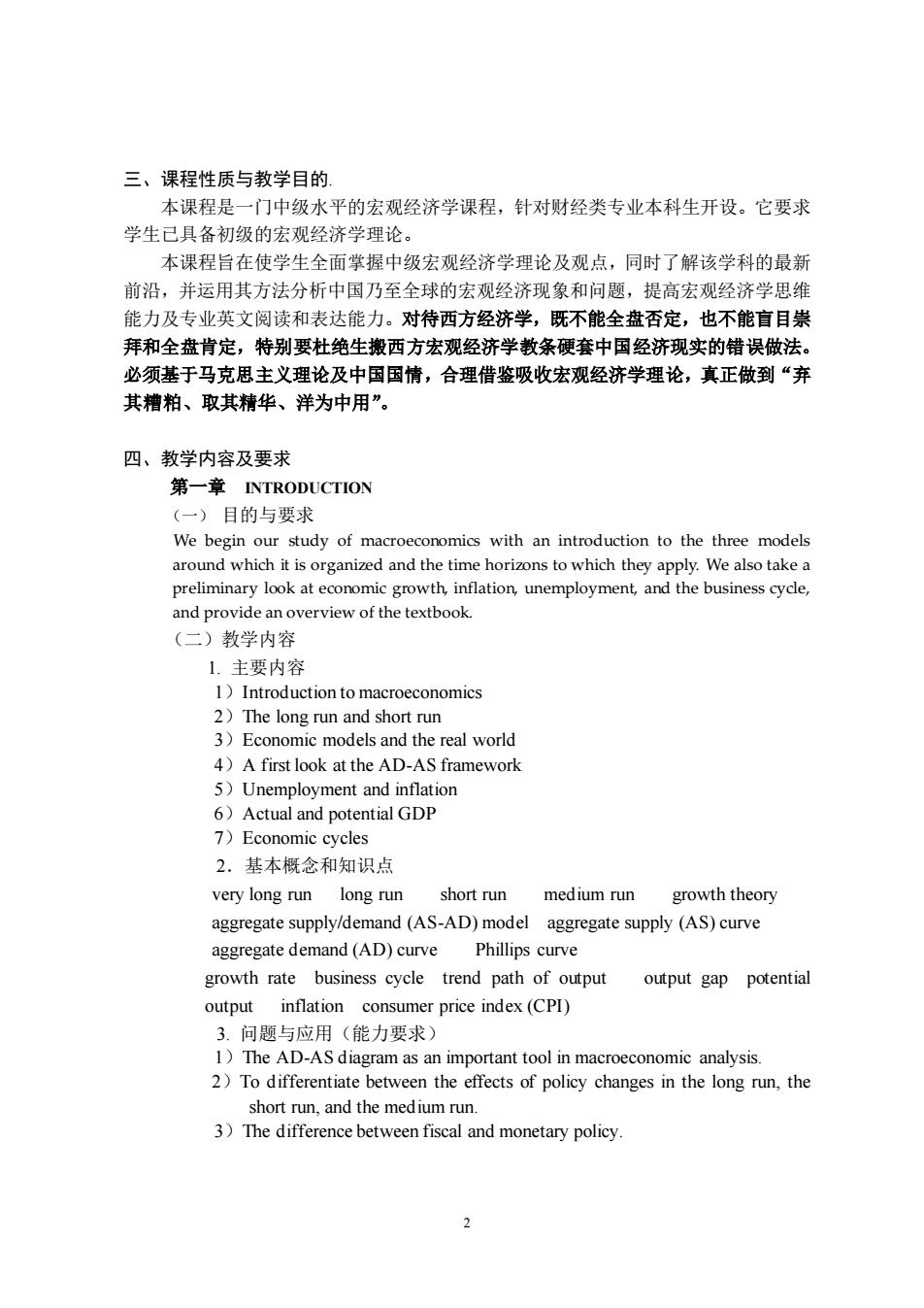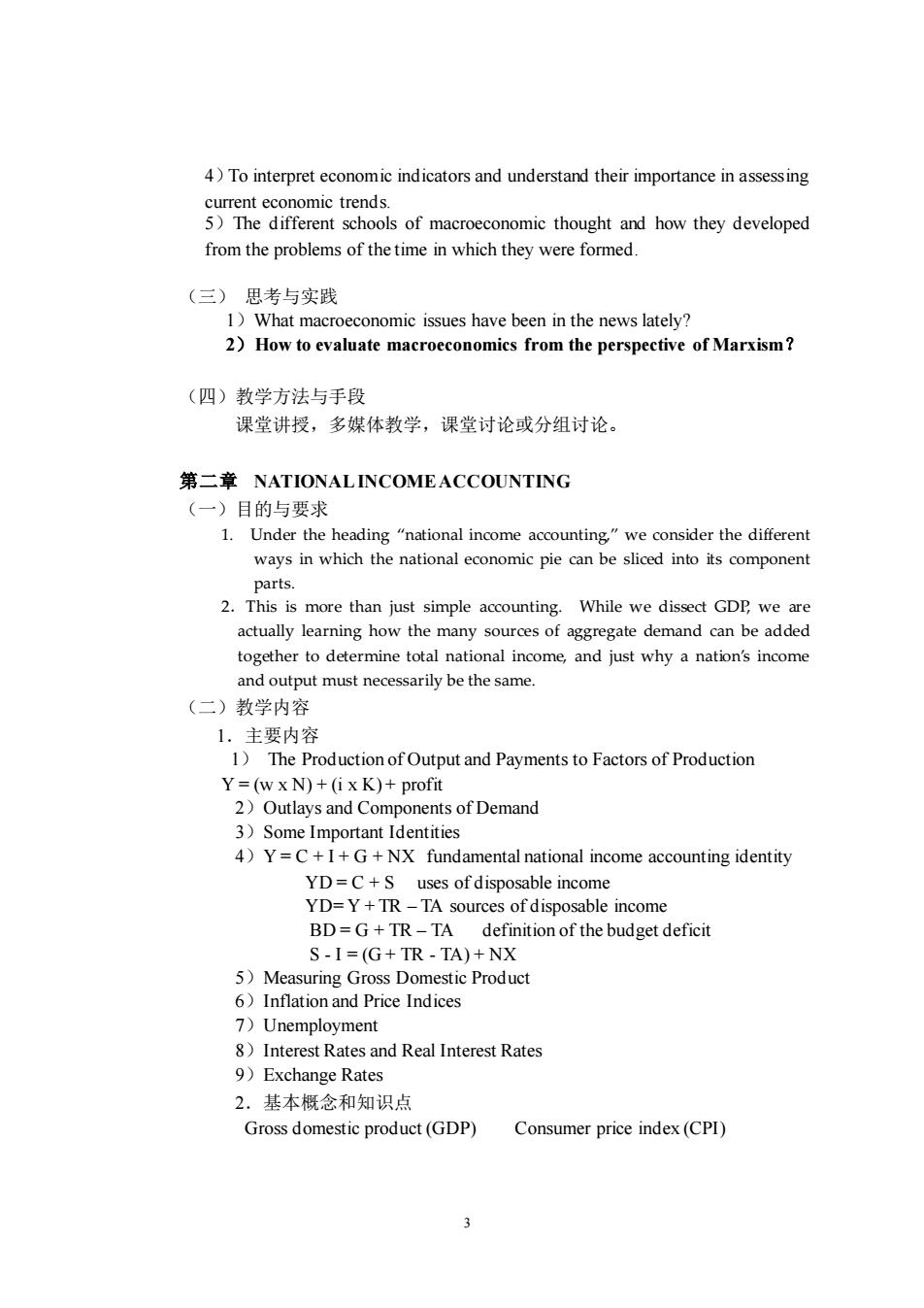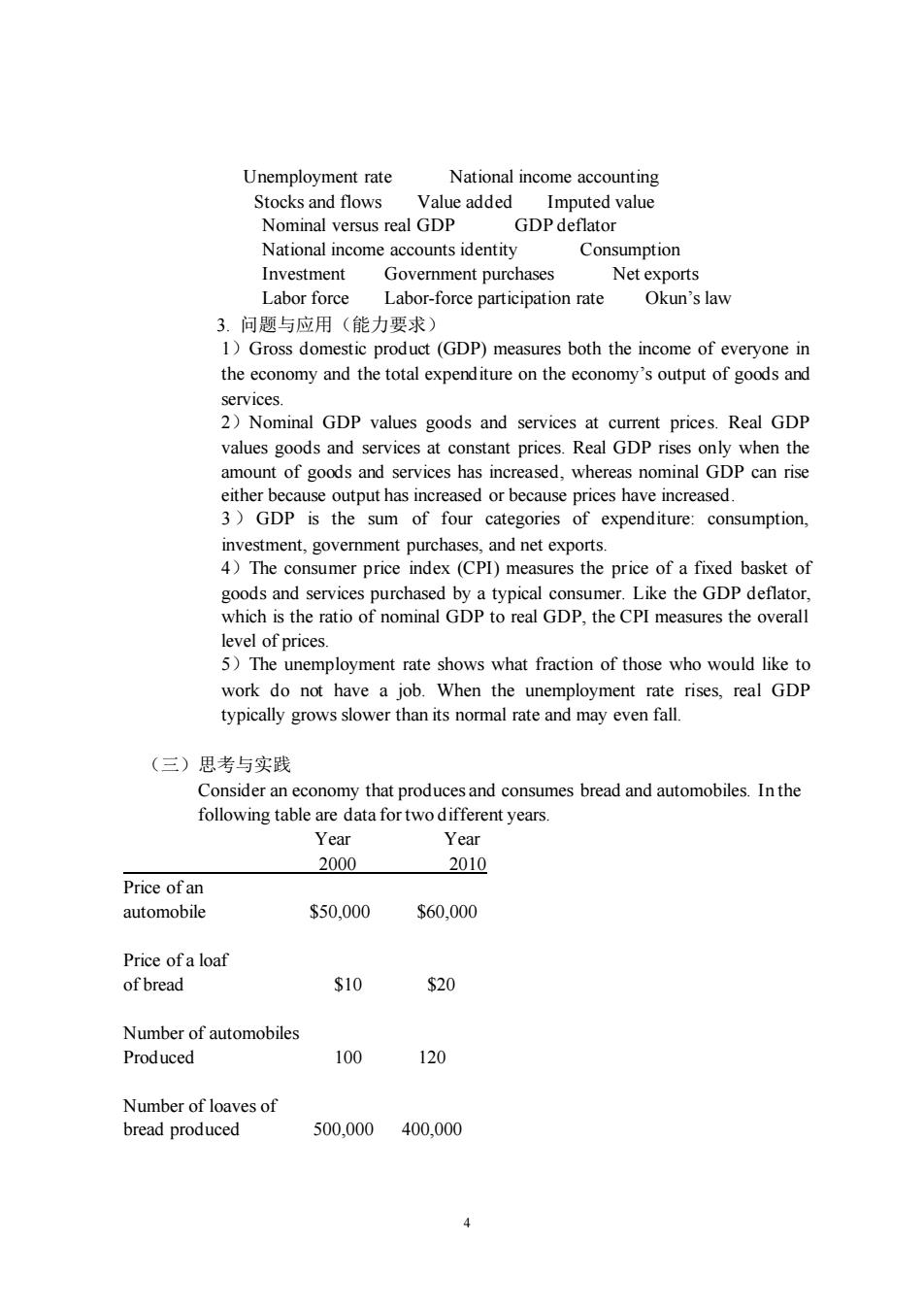
《中级宏观经济学》课程教学大纲 The Course Syllabus of Intermediate Macroeconomics 一、课程基本信息(Basic Course Information) 课程代码:16090203 Course Code:16090203 课程名称:中级宏观经济学 Course Name:Intermediate Macroeconomics 课程类别:专业课 Course Type:Specialized Course 学 时:48 Period:48 学 分:3 Credit 3 适用对象:财经类专业本科生 Target Students:Undergraduate Students Majoring in Economics 考核方式:考试 Assessment:Examination 先修课程:初级宏观经济学,微积分 Preparatory Course:Principles of Macroeconomics,Calculus 二、课程简介(Brief Course Introduction) 中级宏观经济是为财经类本科生开设的一门重要课程。本课程通过模型与实际案 例相结合的方式,向学生介绍中级水平的宏观经济学的主要理论和相关经济政策。它 整合长期与短期、凯恩斯与古典理论,其主要内容包括:宏观经济数据,古典理论, 增长理论,经济周期理论,宏观经济政策的争论等。 Intermediate macroeconomics is an important course for undergraduates of finance and economics.This course provides students with the main theories and related economic policies of intermediate-level macroeconomics through the combination of models and actual cases.It integrates the long-run and short-run issues,Keynesian and classical theories,which include:Macroeconomic Data,Classical Theory,Growth Theory Business Cycle Theory,and Macroeconomic Policy Debates,etc
1 《中级宏观经济学》课程教学大纲 The Course Syllabus of Intermediate Macroeconomics 一、课程基本信息(Basic Course Information) 课程代码:16090203 Course Code:16090203 课程名称:中级宏观经济学 Course Name:Intermediate Macroeconomics 课程类别:专业课 Course Type: Specialized Course 学 时:48 Period: 48 学 分:3 Credit: 3 适用对象: 财经类专业本科生 Target Students: Undergraduate Students Majoring in Economics 考核方式:考试 Assessment: Examination 先修课程:初级宏观经济学,微积分 Preparatory Course: Principles of Macroeconomics, Calculus 二、课程简介(Brief Course Introduction) 中级宏观经济是为财经类本科生开设的一门重要课程。本课程通过模型与实际案 例相结合的方式,向学生介绍中级水平的宏观经济学的主要理论和相关经济政策。它 整合长期与短期、凯恩斯与古典理论,其主要内容包括:宏观经济数据,古典理论, 增长理论,经济周期理论,宏观经济政策的争论等。 Intermediate macroeconomics is an important course for undergraduates of finance and economics. This course provides students with the main theories and related economic policies of intermediate-level macroeconomics through the combination of models and actual cases. It integrates the long-run and short-run issues, Keynesian and classical theories, which include: Macroeconomic Data, Classical Theory, Growth Theory, Business Cycle Theory, and Macroeconomic Policy Debates, etc

三、课程性质与教学目的, 本课程是一门中级水平的宏观经济学课程,针对财经类专业本科生开设。它要求 学生己具备初级的宏观经济学理论。 本课程旨在使学生全面掌握中级宏观经济学理论及观点,同时了解该学科的最新 前沿,并运用其方法分析中国乃至全球的宏观经济现象和问题,提高宏观经济学思维 能力及专业英文阅读和表达能力。对特西方经济学,既不能全盘否定,也不能盲目崇 拜和全盘肯定,特别要杜绝生搬西方宏观经济学教条硬套中国经济现实的错误做法。 必须基于马克思主义理论及中国国情,合理借鉴吸收宏观经济学理论,真正做到“弃 其糟粕、取其精华、洋为中用”。 四、教学内容及要求 第一章INTRODUCTION (一)目的与要求 We begin our study of macroeconomics with an introduction to the three models around which it is organized and the time horizons to which they apply.We also take a preliminary look at economic growth,inflation,unemployment,and the business cycle, and provide an overview of the textbook. (二)教学内容 1.主要内容 1)Introduction to macroeconomics run e real world 4)A first look at the AD-AS framework 5)Unemployment and inflation 6)Actual and potential GDp 7)Ec cycles 2.基本概念和知识点 very long run long rur short run medium run growth theory aggregate supply/demand(AS-AD)model aggregate supply (AS)curve aggregate demand(AD)curve Phillips curve growth rate business cycle trend path of output output gap potential output inflation consumer price index(CPI) 3.问题与应用(能力要求) 1)The AD-AS diagram as an important tool in macroeconomic analysis. 2To differentiate between the effects of policy changes in the long run,the short run,and the medium run. 3)The difference between fiscal and monetary policy. 2
2 三、课程性质与教学目的. 本课程是一门中级水平的宏观经济学课程,针对财经类专业本科生开设。它要求 学生已具备初级的宏观经济学理论。 本课程旨在使学生全面掌握中级宏观经济学理论及观点,同时了解该学科的最新 前沿,并运用其方法分析中国乃至全球的宏观经济现象和问题,提高宏观经济学思维 能力及专业英文阅读和表达能力。对待西方经济学,既不能全盘否定,也不能盲目崇 拜和全盘肯定,特别要杜绝生搬西方宏观经济学教条硬套中国经济现实的错误做法。 必须基于马克思主义理论及中国国情,合理借鉴吸收宏观经济学理论,真正做到“弃 其糟粕、取其精华、洋为中用”。 四、教学内容及要求 第一章 INTRODUCTION (一) 目的与要求 We begin our study of macroeconomics with an introduction to the three models around which it is organized and the time horizons to which they apply. We also take a preliminary look at economic growth, inflation, unemployment, and the business cycle, and provide an overview of the textbook. (二)教学内容 1. 主要内容 1)Introduction to macroeconomics 2)The long run and short run 3)Economic models and the real world 4)A first look at the AD-AS framework 5)Unemployment and inflation 6)Actual and potential GDP 7)Economic cycles 2.基本概念和知识点 very long run long run short run medium run growth theory aggregate supply/demand (AS-AD) model aggregate supply (AS) curve aggregate demand (AD) curve Phillips curve growth rate business cycle trend path of output output gap potential output inflation consumer price index (CPI) 3. 问题与应用(能力要求) 1)The AD-AS diagram as an important tool in macroeconomic analysis. 2)To differentiate between the effects of policy changes in the long run, the short run, and the medium run. 3)The difference between fiscal and monetary policy

4)To interpret economic indicators and understand their importance in assessing 5eofmtho o theydevpd from the problems of the time in which they were formed. (三)思考与实践 1 What macroeconomic issues have been in the news lately? 2)How to evaluate macroeconomics from the perspective of Marxism? (四)教学方法与手段 课堂讲授,名煤体教学,课堂过论或分组计论 第二章NATIONALINCOMEACCOUNTING (一)目的与要求 1.Under the heading"national income accounting"we consider the different ways in which the national economic pie can be sliced into its component 2 is more than just simple accounting.While we dissect GDP we are actually learning how the many sources of aggregate demand can be added together to determine total national income,and just why a nation's income and output must necessarily be the same. (二)教学内容 1。主要内容 1 The Production of Output and Payments to Factors of Production Y=(wx N)+(ix K)+profit 2)Outlays and Components of Demand 3)Some Important Identities 4)Y=C+I+G+NX fundamental national income accounting identity V-YR R- BD=G+TR-TA definition of the budget deficit S-I=(G+TR-TA)+NX 5)Measuring Gross Domestic Product 6)Inflation and Price Indices 7)Unemployment 8)Interest Rates and Real Interest Rates 9)Exchange Rates 2.基本概念和知识点 Gross domestic product(GDP) Consumer price index(CPI) 3
3 4)To interpret economic indicators and understand their importance in assessing current economic trends. 5)The different schools of macroeconomic thought and how they developed from the problems of the time in which they were formed. (三) 思考与实践 1)What macroeconomic issues have been in the news lately? 2)How to evaluate macroeconomics from the perspective of Marxism? (四)教学方法与手段 课堂讲授,多媒体教学,课堂讨论或分组讨论。 第二章 NATIONAL INCOME ACCOUNTING (一)目的与要求 1. Under the heading “national income accounting,” we consider the different ways in which the national economic pie can be sliced into its component parts. 2.This is more than just simple accounting. While we dissect GDP, we are actually learning how the many sources of aggregate demand can be added together to determine total national income, and just why a nation’s income and output must necessarily be the same. (二)教学内容 1.主要内容 1) The Production of Output and Payments to Factors of Production Y = (w x N) + (i x K) + profit 2)Outlays and Components of Demand 3)Some Important Identities 4)Y = C + I + G + NX fundamental national income accounting identity YD = C + S uses of disposable income YD= Y + TR – TA sources of disposable income BD = G + TR – TA definition of the budget deficit S - I = (G + TR - TA) + NX 5)Measuring Gross Domestic Product 6)Inflation and Price Indices 7)Unemployment 8)Interest Rates and Real Interest Rates 9)Exchange Rates 2.基本概念和知识点 Gross domestic product (GDP) Consumer price index (CPI)

Unemployment rate National income accounting Stocks and flows Value added Imputed value Nominal versus real GDP GDP deflator National income accounts identity Consumption Investment Net exports Labor force Labor-force participation rate Okun's law 3.问题与应用(能力要求) 1ross domestic product (GDP)measures both the incm of everyoe in the economy and the services. 2)Nominal GDp values goods and services at current prices.Real GDp values goods and services at constant prices.Real GDP rises only when the amon of os and has increased,where nomi al gde can rise pu as reased or because prices have inc ased 3)GDP is the sum of four categories of expenditure:consumption, investment,government purchases,and net exports. 4)The consumer price index(CPI)measures the price of a fixed basket of urchased by a t er.Like the GDP deflator th atio typical consu of nominal GDP to real GDP,the CPI measures the overal level of prices 5)The unemployment rate shows what fraction of those who would like to work do not have a job.When the unemployment rate rises,real GDP typically grows slower than its normal rate and may even fall. (三)思考与实践 Consider an economy that produces and consumes bread and automobiles.In the following table are data fortwo different years. Year 2000 2010 Price of an automobile $50000 $60.000 Price ofa loaf of bread $10 $20 Number of automobiles Produced 100 120 500.000 400,000 4
4 Unemployment rate National income accounting Stocks and flows Value added Imputed value Nominal versus real GDP GDP deflator National income accounts identity Consumption Investment Government purchases Net exports Labor force Labor-force participation rate Okun’s law 3. 问题与应用(能力要求) 1)Gross domestic product (GDP) measures both the income of everyone in the economy and the total expenditure on the economy’s output of goods and services. 2)Nominal GDP values goods and services at current prices. Real GDP values goods and services at constant prices. Real GDP rises only when the amount of goods and services has increased, whereas nominal GDP can rise either because output has increased or because prices have increased. 3 ) GDP is the sum of four categories of expenditure: consumption, investment, government purchases, and net exports. 4)The consumer price index (CPI) measures the price of a fixed basket of goods and services purchased by a typical consumer. Like the GDP deflator, which is the ratio of nominal GDP to real GDP, the CPI measures the overall level of prices. 5)The unemployment rate shows what fraction of those who would like to work do not have a job. When the unemployment rate rises, real GDP typically grows slower than its normal rate and may even fall. (三)思考与实践 Consider an economy that produces and consumes bread and automobiles. In the following table are data for two different years. Year Year 2000 2010 Price of an automobile $50,000 $60,000 Price of a loaf of bread $10 $20 Number of automobiles Produced 100 120 Number of loaves of bread produced 500,000 400,000

a.Using the year 2000 as the base year,compute the following statistics for each year nominal GDP,real GDP,the implicit price deflator for GDP,and a fixed-weight price index such as the CPl b.How much have prices risen between year 2012 and year 2016?Compare the answers given by the Laspeyres and Paasche price indices.Explain the difference c.Suppose you are a senator writing a bill to index Social Security and federal pensions That is your bill will adiust these benefits to offset changes in the cost of iving.Will you use the GDP deflator or the CPI?Why? (四)教学方法与手段 课堂讲授,多媒体教学,课堂讨论或分组讨论 第三章GROWTHAND ACCUMULATION (一)目的与要求 1.In this chapter we study how potential output-the output that would be produced if all factors were fully employed-grows over time. 2 To better accon lish this.we leam gr wth ting and the fundamentals of neoclassical growth theory. Together,they tell us that output growth results both from improvements in technology and from increases in one or more of the inputs to the production process-capital,labor,and natural resources.Neoclassical growth theory also tells us that in the long run,growth in potential output results ntirely from technological improvement (二)教学内容 1,主要内容 1)GrowthAccounting Growth accounting The Cobb-Douglas production function The marginal product of labor and capital 2)Empirical Estimates of Growth Convergence Total factor productivity The importance of human capital 3)Growth Theory The Neoclassical Model The neoclassical growth model The steady-state equilibrium: sfik)=(n d)k* krepresents the steady-state value of k.The steady-state value ofy isy"f(k). The golden-rule capital stock
5 _______________________________________ a. Using the year 2000 as the base year, compute the following statistics for each year: nominal GDP, real GDP, the implicit price deflator for GDP, and a fixed-weight price index such as the CPI. b. How much have prices risen between year 2012 and year 2016? Compare the answers given by the Laspeyres and Paasche price indices. Explain the difference. c. Suppose you are a senator writing a bill to index Social Security and federal pensions. That is, your bill will adjust these benefits to offset changes in the cost of living. Will you use the GDP deflator or the CPI? Why? (四)教学方法与手段 课堂讲授,多媒体教学,课堂讨论或分组讨论。 第三章 GROWTH AND ACCUMULATION (一)目的与要求 1. In this chapter we study how potential output⎯the output that would be produced if all factors were fully employed⎯grows over time. 2. To better accomplish this, we learn growth accounting and the fundamentals of neoclassical growth theory. Together, they tell us that output growth results both from improvements in technology and from increases in one or more of the inputs to the production process⎯capital, labor, and natural resources. Neoclassical growth theory also tells us that in the long run, growth in potential output results entirely from technological improvement. (二)教学内容 1.主要内容 1) Growth Accounting Growth accounting The Cobb-Douglas production function The marginal product of labor and capital 2) Empirical Estimates of Growth Convergence Total factor productivity The importance of human capital 3) Growth Theory: The Neoclassical Model The neoclassical growth model The steady-state equilibrium : sf(k*) = (n + d)k* k* represents the steady-state value of k. The steady-state value of y is y* = f(k*). The golden-rule capital stock